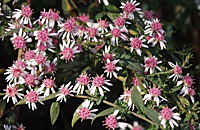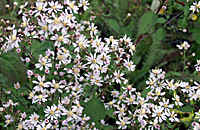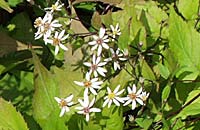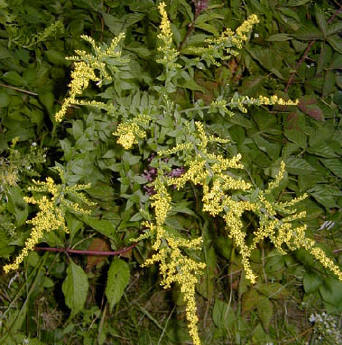 What do you do for fall color? Want something else other than fall
mums?
What do you do for fall color? Want something else other than fall
mums?
Look around. The colors you see in October are often times in leaves, seeds and weeds. Weeds? How can we use weeds in our fall landscape?
Many of these "weeds" are asters and goldenrod. Purples, whites and yellows color our floors along roads, in fields, and along the wood's edge. Taking
a hint from nature, these native perennials are easy to grow, and flourish in full sun to part shade and well drained soils. Plant breeders have recognized the value in these
native plants and are working on improved cultivars of asters and goldenrod.
 Aster lateriflorus 'Lady in Black' has been around for quite awhile, but not often
seen in landscapes, and I don't know why. This lovely aster is a dutch selection of our native aster found in the garden of Herman Van Beusekom. Its dark foliage appears in
spring and continues to be a dark green to red throughout the summer. This aster reaches about 2-2 ½ feet by August and will get just as wide. In mid to late September, it
graces us with tiny pale pink to white flowers with pink centers. I just saw this plant in full bloom in my friend's butterfly garden and it was just spectacular! It also
looks great in containers for porches as a substitution for the chrysanthemum.
Aster lateriflorus 'Lady in Black' has been around for quite awhile, but not often
seen in landscapes, and I don't know why. This lovely aster is a dutch selection of our native aster found in the garden of Herman Van Beusekom. Its dark foliage appears in
spring and continues to be a dark green to red throughout the summer. This aster reaches about 2-2 ½ feet by August and will get just as wide. In mid to late September, it
graces us with tiny pale pink to white flowers with pink centers. I just saw this plant in full bloom in my friend's butterfly garden and it was just spectacular! It also
looks great in containers for porches as a substitution for the chrysanthemum.
 Blue wood aster, Aster coridifolius, is a lovely aster to add some blue into the fall
garden. This plant can get to 4 feet tall, something you need to plant towards the middle of your garden. It does tend to flop over, but in my garden I let it do its thing.
In the native plant garden at the Ag Center, it is the highlight of the fall. It prefers part shade, but will do fine in full sun, as long as it is kept watered. Throughout
the summer their heart shaped leaves provide some texture to the garden. This is my daughter's favorite perennial in our garden. In late July the buds begin to form. My
daughter watches and waits. Finally it explodes in a mound of blue flowers in late September - early October. The flowers are well worth the anticipation.
Blue wood aster, Aster coridifolius, is a lovely aster to add some blue into the fall
garden. This plant can get to 4 feet tall, something you need to plant towards the middle of your garden. It does tend to flop over, but in my garden I let it do its thing.
In the native plant garden at the Ag Center, it is the highlight of the fall. It prefers part shade, but will do fine in full sun, as long as it is kept watered. Throughout
the summer their heart shaped leaves provide some texture to the garden. This is my daughter's favorite perennial in our garden. In late July the buds begin to form. My
daughter watches and waits. Finally it explodes in a mound of blue flowers in late September - early October. The flowers are well worth the anticipation.
 Aster divaricata 'Eastern Star' is an aster that stays compact, about 18 inches. These dainty
white flowers cover the tops of the dark flower stems in late September. A nice plant for containers due to its compact size, it thrives in part sun. This species is often
seen along woods edge. It's light and airy flowers are a welcome to any perennial garden.
Aster divaricata 'Eastern Star' is an aster that stays compact, about 18 inches. These dainty
white flowers cover the tops of the dark flower stems in late September. A nice plant for containers due to its compact size, it thrives in part sun. This species is often
seen along woods edge. It's light and airy flowers are a welcome to any perennial garden.
Two introductions from Mt. Cuba are Aster laevis 'Bluebird' and Aster 'novae-angliae 'Purple Dome'. Both are full sun asters but have very different
habits. Bluebird is a tall plant, reaching four feet. It has large violet-blue flowers almost one inch across, blooming in September - October. Aster 'Purple Dome' is a
compact grower, only stretching to about 18 inches. Purple Dome has very dark lavender-purple flowers covering the foliage. This aster would be another great substitution for
the chrysanthemum.
 Goldenrod, Solidago spp., is an underused native plant in our gardens that will grow
well in full sun and average soils. Two cultivars that are commonly found in nurseries are Solidago rugosa 'Fireworks' and Solidago sphacelata 'Golden Fleece'. Both have the
wonderful fall golden color to the flowers and arching branches. I particularly like the dark green foliage that covers the ground throughout the summer. These plants look
great with the asters; purple and gold look fantastic together. 'Fireworks' is a taller cultivar, about three to four feet high, whereas Golden Fleece stays at about 18
inches, making it a good container plant. Also worth noting is that goldenrod is deer resistant.
Goldenrod, Solidago spp., is an underused native plant in our gardens that will grow
well in full sun and average soils. Two cultivars that are commonly found in nurseries are Solidago rugosa 'Fireworks' and Solidago sphacelata 'Golden Fleece'. Both have the
wonderful fall golden color to the flowers and arching branches. I particularly like the dark green foliage that covers the ground throughout the summer. These plants look
great with the asters; purple and gold look fantastic together. 'Fireworks' is a taller cultivar, about three to four feet high, whereas Golden Fleece stays at about 18
inches, making it a good container plant. Also worth noting is that goldenrod is deer resistant.
Another note concerning all these native plants mentioned is that they are all butterfly attractants. When designing your butterfly garden, be sure to
keep asters and goldenrod in mind. These plants also make great cut flowers. Take time to design your garden and think of all four seasons. Keep on the look-out for native
cultivars that you can incorporate in your garden, and always enjoy gardening!
Read other articles on garden and landscape design
Read other fall related gardening articles